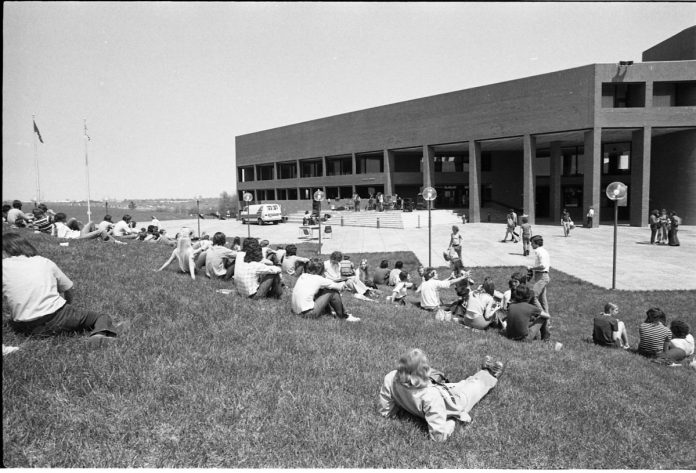Joseph Adams
News Editor
Where It All Began
Johnson County Community College as we know it opened its doors to welcome students and staff in 1972.
Before this, the college operated all over the city in various elementary schools and other buildings, a collective education endeavor which officially began in 1969.
Does the surname Billington sound familiar? The library was named after Wilbur Billington, who involved himself in the early days of the college by chairing a study in Johnson County to study the viability of a community college in the area.
This study coincided with the Community College Act of 1965, which gave states the ability to set up community colleges that reported to the Department of Education (According to “A History of Johnson County Community College 1969-1999”).
Billington became one of the first board of trustees and was instrumental in the founding of the college. When Billington worked on the study testing the college’s feasibility, he worked with the League of Women voters and other prominent community organizations.
Ellen Laner, former president of the League of Women Voters, was also among the first trustee members.
Another important piece of the study was Virginia Krebs; as written in “The Pride of the Past and Promise of the Future,” a novel written to commemorate the colleges 40th anniversary, Krebs said that “Johnson County Community College would become the cultural and educational center of the community.”
During the first-ever semester of the college, available courses included secretarial sciences, office machines 160, production typing 157, intro to power plants and flight hostess intro classes.
The Significance of the ’70s
It is important to consider the backdrop of the college’s foundation; when the college opened, the Civil Rights Act of 1964 had just passed five years earlier, the Vietnam war was ongoing, students had to take more than 12 credit hours to receive draft deferment, creating intense pressure to do well in school to avoid potential drafting.
Racial inequality was rampant in the United States, and the sixties and seventies were considered a time of great tumult and upheaval.
The first president of the college had to work to quell student protests at JCCC after Ohio National Guard members shot and killed students at Kent State.
According “A History of Johnson County Community College 1969-1999,” the president of the college at the time, President Harris, asked his lawyer if there was any way to take legal action against student protestors.
Student protestors at the time were planning to fly the American flag upside down in front of the Merriam building. They resolved these issues by allowing students to have an hour open-mic every day in the temporary student union to voice their concerns and feelings.
Before and After the Carlsen Years
Another significant era of the college was under Charles Carlsen’s presidency which spanned 25 years, from 1981 to 2006. This term was unusually long for a college president.
President Joe Sopcich, who is completing his sixth year as president of the college, said: “In today’s world, people in [college president] positions are staying in them, on average, about three years, so there is a lot of turnover that goes on.”
Considering that the average tenure of a college is president is three years, the length that Carlsen held that office is about eight times as long as the norm.
The college saw expansion and national notoriety under his tenure. One of Carlsen’s biggest successes was the partnership with Burlington North Santa Fe Railway (BNSF) that invested in a campus building and was used a model for future community colleges across the country, as stated in the book “The Pride of the Past the Promise of the Future.”
Carlsen also began the Some Enchanted Evening gala that, to this day, raises substantial amounts of money for college scholarships.
It was only in the final year of his presidency that reports of sexual assault by Carlsen were publicized, leading to his hasty resignation and creating protest about his namesake, the Carlsen Center.
Then and Now: The Little Things
In 1975 the tuition at the college for in state residents was $13 per credit hour and $27 per hour for out-of-state students, according to a JCCC course catalog from 1975.
For reference, it is now $88 per credit hour for Johnson County residents. The original campus consisted of six buildings: the Electronic Media Center (EMC) now known as Billington Library; the General Education Building (GEB), the Science Building (SCI), the Commons (COM), the Central Services Building (CSB) and the GYM.
Over the years, the campus expanded to include 23 buildings, including the new Fine Arts and Design (FAD) and Career and Technical Education Center (CTE) buildings.
The first graduation ceremony held in 1971 passed out degrees to 176 students. In comparison, the graduating class of 2018 received 3,471 degrees.
The college truly is an important landmark to the Overland Park community, and the future looks bright — here’s to 50 more years.
This story was featured in our 50th anniversary edition.






















